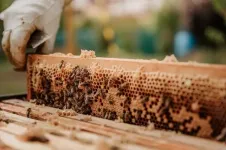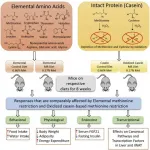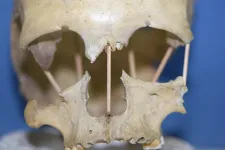(Press-News.org) More than 90 years ago, astronomer Edwin Hubble observed the first hint of the rate at which the universe expands, called the Hubble constant.
Almost immediately, astronomers began arguing about the actual value of this constant, and over time, realized that there was a discrepancy in this number between early universe observations and late universe observations.
Early in the universe's existence, light moved through plasma--there were no stars yet--and from oscillations similar to sound waves created by this, scientists deduced that the Hubble constant was about 67. This means the universe expands about 67 kilometers per second faster every 3.26 million light-years.
But this observation differs when scientists look at the universe's later life, after stars were born and galaxies formed. The gravity of these objects causes what's called gravitational lensing, which distorts light between a distant source and its observer.
Other phenomena in this late universe include extreme explosions and events related to the end of a star's life. Based on these later life observations, scientists calculated a different value, around 74. This discrepancy is called the Hubble tension.
Now, an international team including a University of Michigan physicist has analyzed a database of more than 1,000 supernovae explosions, supporting the idea that the Hubble constant might not actually be constant.
Instead, it may change based on the expansion of the universe, growing as the universe expands. This explanation likely requires new physics to explain the increasing rate of expansion, such as a modified version of Einstein's gravity.
The team's results are published in the Astrophysical Journal.
"The point is that there seems to be a tension between the larger values for late universe observations and lower values for early universe observation," said Enrico Rinaldi, a research fellow in the U-M Department of Physics. "The question we asked in this paper is: What if the Hubble constant is not constant? What if it actually changes?"
The researchers used a dataset of supernovae--spectacular explosions that mark the final stage of a star's life. When they shine, they emit a specific type of light. Specifically, the researchers were looking at Type Ia supernovae.
These types of supernovae stars were used to discover that the universe was expanding and accelerating, Rinaldi said, and they are known as "standard candles," like a series of lighthouses with the same lightbulb. If scientists know their luminosity, they can calculate their distance by observing their intensity in the sky.
Next, the astronomers use what's called the "redshift" to calculate how the universe's rate of expansion might have increased over time. Redshift is the name of the phenomenon that occurs when light stretches as the universe expands.
The essence of Hubble's original observation is that the further away from the observer, the more wavelength becomes lengthened--like you tacked a Slinky to a wall and walked away from it, holding one end in your hands. Redshift and distance are related.
In Rinaldi's team's study, each bin of stars has a fixed reference value of redshift. By comparing the redshift of each bin of stars, the researchers can extract the Hubble constant for each of the different bins.
In their analysis, the researchers separated these stars based on intervals of redshift. They placed the stars at one interval of distance in one "bin," then an equal number of stars at the next interval of distance in another bin, and so on. The closer the bin to Earth, the younger the stars are.
"If it's a constant, then it should not be different when we extract it from bins of different distances. But our main result is that it actually changes with distance," Rinaldi said. "The tension of the Hubble constant can be explained by some intrinsic dependence of this constant on the distance of the objects that you use."
Additionally, the researchers found that their analysis of the Hubble constant changing with redshift allows them to smoothly "connect" the value of constant from the early universe probes and the value from the late universe probes, Rinaldi said.
"The extracted parameters are still compatible with the standard cosmological understanding that we have," he said. "But this time they just shift a little bit as we change the distance, and this small shift is enough to explain why we have this tension."
The researchers say there are several possible explanations for this apparent change in the Hubble constant--one being the possibility of observational biases in the data sample. To help correct for potential biases, astronomers are using Hyper Suprime-Cam on the Subaru Telescope to observe fainter supernovae over a wide area. Data from this instrument will increase the sample of observed supernovae from remote regions and reduce the uncertainty in the data.
INFORMATION:
The team was led by Maria Dainotti, assistant professor at the National Astronomical Observatory of Japan and the Graduate University for Advanced Studies, SOKENDAI in Japan and an affiliated scientist at the U.S. Space Science Institute. Rinaldi is also a researcher in the Theoretical Quantum Physics Laboratory and the Interdisciplinary Theoretical and Mathematical Sciences program at the research institute RIKEN in Japan.
Fellow researchers include Biagio De Simone, a former master's student at the University of Salerno; Tiziano Schiavone, a graduate student at the University of Pisa; Giovanni Montani, adjunct professor at the University of Rome "La Sapienza" and researcher at ENEA; Gaetano Lambiase, professor at the University of Salerno.
Study abstract: On the Hubble Constant Tension in the See Ia Pantheon Sample (full text)
Image link: https://drive.google.com/drive/folders/1rFU5qGC80erVN9R0xHks58qMIWE6Gflq
Study: https://iopscience.iop.org/article/10.3847/1538-4357/abeb73
BOSTON - Dana-Farber Cancer Institute researchers are presenting dozens of research studies at the 2021 Annual Meeting of the American Society of Clinical Oncology (ASCO). The studies will be presented during the virtual program on June 4-8, 2021. ASCO is the world's largest clinical cancer research meeting, attracting more than 30,000 oncology professionals from around the world.
Toni K. Choueiri, MD, the director of the Lank Center for Genitourinary Oncology at Dana-Farber, will present results from the randomized, double-blind, phase III KEYNOTE-564 trial evaluating pembrolizumab versus placebo after surgery in patients with renal cell carcinoma (abstract LBA5) during ASCO's Plenary Session on Sunday, June ...
CHAMPAIGN, Ill. -- Solid-state batteries pack a lot of energy into a small space, but their electrodes are not good at keeping in touch with their electrolytes. Liquid electrolytes reach every nook and cranny of an electrode to spark energy, but liquids take up space without storing energy and fail over time. Researchers are now putting solid electrolytes in touch with electrodes made of strategically arranged materials - at the atomic level - and the results are helping drive better solid-state battery technologies.
A new study, led by University of Illinois Urbana-Champaign materials science and engineering professor Paul Braun, postdoctoral research associate Beniamin Zahiri, and Xerion Advanced Battery Corp. director of research and development ...
The University of Maryland (UMD) co-published a new review paper in the Annual Review of Resource Economics to examine pollinators from both an economic and ecological perspective, providing much needed insight into the complexities of valuing pollination. Pollinators are not only a critical component of a healthy ecosystem, but they are also necessary to produce certain foods and boost crop yields. While native and wild pollinators (whether they be certain bee species, other insects and animals, or just the wind) still play an important role, managed honey bee colonies are commercially trucked around the U.S. to meet the need for pollination services in agricultural products. Recent reports of ...
BATON ROUGE, Louisiana - A diet that improves the biomarkers of metabolic health, and that could potentially slow the aging process, has moved a step closer to reality.
"We've known for years that restricting the amino acid methionine in the diet produces immediate and lasting improvements in nearly every biomarker of metabolic health," said Thomas W. Gettys, PhD, Professor and Director, Nutrient Sensing and Adipocyte Signaling Laboratory at Pennington Biomedical Research Center. "The problem is that methionine-restricted diets have been difficult to implement because they taste so bad."
Until now. Restricting methionine normally involves diets formulated with elemental (e.g., individual) amino acids. Individual amino acids are the building blocks ...
May 20, 2021 - Women with a history of weight cycling - losing and regaining 10 pounds or more, even once - have increased rates of insomnia and other sleep problems, reports a study in The Journal of Cardiovascular Nursing, official journal of the Preventive Cardiovascular Nurses Association. The journal is published in the Lippincott portfolio by Wolters Kluwer.
"History of weight cycling was prospectively associated with several measures of poor sleep, including short sleep duration, worse sleep quality, greater insomnia, greater sleep disturbances, ...
Melting glaciers and polar ice sheets are among the dominant sources of sea-level rise, yet until now, the water beneath them has remained hidden from airborne ice-penetrating radar.
With the detection of groundwater beneath Hiawatha Glacier in Greenland, researchers have opened the possibility that water can be identified under other glaciers from the air at a continental scale and help improve sea-level rise projections. The presence of water beneath ice sheets is a critical component currently missing from glacial melt scenarios that may greatly impact how quickly seas rise - for example, by enabling big chunks of ice to calve ...
New research led by the University of Kent's School of Psychology has found that some brain activity methods used to detect incriminating memories do not work accurately in older adults.
Findings show that concealed information tests relying on electrical activity of the brain (electroencephalography [EEG]) are ineffective in older adults because of changes to recognition-related brain activity that occurs with aging.
EEG-based forensic memory detection is based on the logic that guilty suspects will hold incriminating knowledge about crimes they have committed, and therefore their brains will elicit a recognition response ...
For the first time, researchers have successfully sequenced the entire genome from the skull of Peştera Muierii 1, a woman who lived in today's Romania 35,000 years ago. Her high genetic diversity shows that the out of Africa migration was not the great bottleneck in human development but rather this occurred during and after the most recent Ice Age. This is the finding of a new study led by Mattias Jakobsson at Uppsala University and being published in Current Biology.
"She is a bit more like modern-day Europeans than the individuals in Europe 5,000 years earlier, but the difference is much less than we had thought. We can see that she is not a direct ancestor of modern Europeans, but she is a predecessor of the hunter-gathers that lived in Europe until the end of the last ...
DURHAM, N.C. - A newly identified group of antibodies that binds to a coating of sugars on the outer shell of HIV is effective in neutralizing the virus and points to a novel vaccine approach that could also potentially be used against SARS-CoV-2 and fungal pathogens, researchers at the Duke Human Vaccine Institute report.
In a study appearing online May 20 in the journal Cell, the researchers describe an immune cell found in both monkeys and humans that produces a unique type of anti-glycan antibody. This newly described antibody has the ability to attach ...
Juvenile salmon migrating to the sea in the Sacramento River face a gauntlet of hazards in an environment drastically modified by humans, especially with respect to historical patterns of stream flow. Many studies have shown that survival rates of juvenile salmon improve as the amount of water flowing downstream increases, but "more is better" is not a useful guideline for agencies managing competing demands for the available water.
Now fisheries scientists have identified key thresholds in the relationship between stream flow and salmon survival that can serve as actionable targets for managing water resources in the Sacramento River. The new analysis, published May 19 in Ecosphere, revealed nonlinear ...





